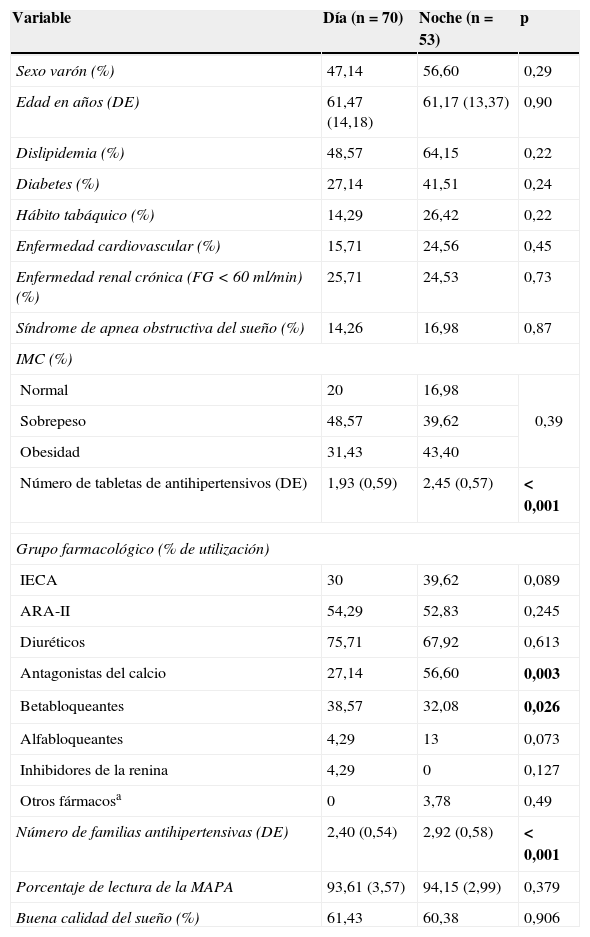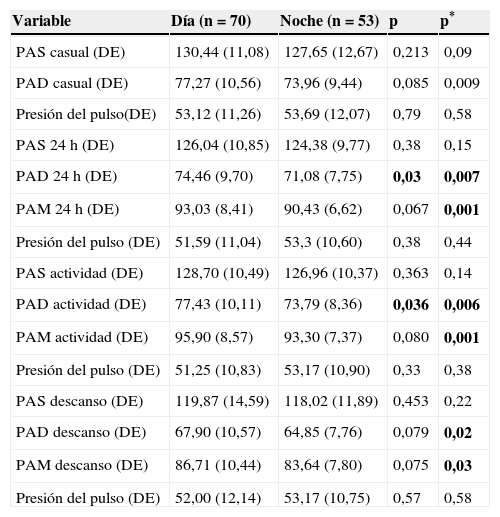Se analizaron 123 registros de presión arterial (PA) efectuados mediante monitorización ambulatoria de PA realizados durante el año 2011 en un hospital universitario español de tercer nivel, con el objetivo de determinar si existían diferencias según la hora de la administración de la medicación en las medias de PA en los 3 períodos (24h, actividad y descanso) en aquellos pacientes que tomaban 2, 3 o 4 fármacos antihipertensivos.
Pacientes y métodoSe compararon aquellos sujetos que tomaban toda la medicación durante el día (grupo 1, n=70) con aquellos que tomaban al menos uno de los antihipertensivos por la noche (grupo 2, n=53).
ResultadosSe observaron diferencias significativas, con medias inferiores de PA diastólica en el grupo 2 durante el período de 24h, actividad y noche; medias inferiores de PA sistólica casual; y medias inferiores de PA media en los 3 períodos, con una tendencia (no significativa) a medias inferiores para PA sistólica a favor del grupo 2. En el cociente de variación noche/día no se alcanzaron diferencias significativas. Sí se encontraron entre ambos grupos en cuanto al número de fármacos utilizado (medias superiores en el grupo 2) y en el tipo de fármaco empleado (betabloqueantes y antagonistas del calcio). Se realizó un análisis multivariante ajustando a estas variables, en el que se mantuvo la significación estadística.
ConclusiónLa administración de parte de la medicación antihipertensiva por la noche podría contribuir a unas menores cifras de PA, lo que plantea la conveniencia de considerar esta estrategia en pacientes con hipertensión arterial no controlada.
In this study, 123 recordings of blood pressure (BP) obtained by ambulatory BP monitoring were analyzed. These recordings were measured in 2011 in patients from a Spanish tertiary university hospital. All participating patients were treated with 2, 3 or 4 anti-hypertensive drugs. The main aim of this study was to determine differences in BP control, if any, depending on the medication schedule. Thus, BP levels were studied at 3 periods of the day: activity hours, rest hours and 24h.
Patients and methodWe compared subjects taking all anti-hypertensive agents during the day (n=70, group 1) with those taking at least one at night (n=53, group 2).
ResultsSignificant differences were found on diastolic BP, where group 2 patients had lower levels at activity, 24h periods and sleep-time. Even if it was not statistically significant, lower levels of systolic BP from group 2 were also observed at activity and 24h periods as well as lower levels of systolic, diastolic and mean BP at rest hours periods. There were also significant group differences in relation to the number of prescribed agents (with the mean being higher for group 2) and the type of agent (beta-blockers and calcium antagonists were more prevalent in group 2). Nevertheless, the multivariate regression analysis done taking into account these variables did not change the observed statistical significance.
ConclusionThe administration of anti-hypertensive drugs at night could be associated with lower BP levels.
Artículo
Comprando el artículo el PDF del mismo podrá ser descargado
Precio 19,34 €
Comprar ahora








